Recipes for Autumn Foods
Autumn is one of the most bountiful times of the year for wild foragers as the trees and shrubs expend the last of their energies into the final maturation of their fruit and seeds. If you know what you're looking for and what your are doing then you can stock-up your larder essentially for free! Here I will go through some of the commonest and most easily identifiable autumn foods and provide links to places where you can find recipes and identification guides for those foods. I'm going to try and put the list in chronological order as well so that you will better know what to find and when.
1. Blackberries
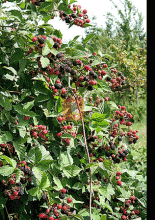
The humble blackberry is probably one of the most familiar of our woodland and roadside plants. It's certainly the plant most people know and the wild food that most people will gather for themselves. The blackberry plant is a rambling shrub and typically fruit can be found from mid July to the end of September, though in a mild autumn you can find maturing fruit until mid October. As a result, this plant just makes it into list of autumn fruit. Of course, it deserves to be here simply by virtue of how enormously versatile it is. It can be made into jams and preserves, desserts, ices, stews, cakes and so much more. If you don't believe me, then see this link list of blackberry recipes where there are over 50 recipes.
2. Elderberries
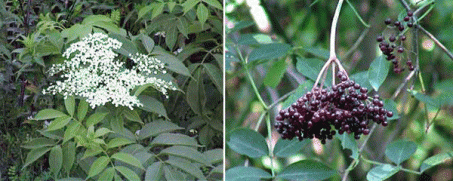
Elderberries are the fruit of the Elder tree, sometimes known as the 'witch tree'. These dark fruit are packed with vitamin C and make excellent eating for the wild forager, as long as you can grab them before the birds. Typically they will ripen in early September and generally you can pick until late September. The easiest way to get these fruit is to pick the entire fruit spray then, when you get home, use a fork to pry the fruit away from the stalk. This is an extremely versatile autumn fruit that can be used in just about any recipe where you would use blackcurrants or blackberries. The rich taste of the fruit makes excellent desserts, jams, ice creams and sorbets as well as being a flavoursome addition to meat stews and sauces. If you would like some elderberry recipes then see this list of elderbery recipes where you will find a list of almost 40 recipes for this fruit.
3. Sloes

Sloes are the fruit of the blackthorn tree and are usually ripe around mid September. Most people will recognize this fruit as the 'sloe' and tend to collect it solely for making sloe gin. However, the fruit is a member of the plum family and despite not having much flesh it offers a huge flavour punch. As a result this can be much more versatile than most people think and sloe jams and jellies are truly marvellous. Why not give sloes a go as an ingredient! Here you will find an extensive collection of sloe-based recipes.
4. Haws

Haws are the fruit of the hawthorn tree. You see then everywhere in the hedgerows from early September onwards and they are typically ripe from this time. Admittedly they are not particularly exciting as a fruit but they are plentiful and will bulk-out other autumnal fruit. They also contain lots of pectin and are useful for helping in the setting of jams and jellies. They can be used in pies and make a base for meat sauces as well. See this selection of hawthorn berry (haw )recipes for more information.
5. Rose Hips
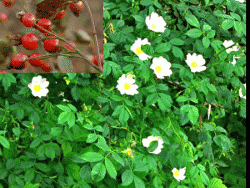
Rose hips are the fruit of the rose bush and the most common wild or semi-wild types are the hips of the dog rose and the hips of the Rugosa rose. Both are edible, with the rugosa rose typically maturing before the dog rose. This is one of my favourite autumnal fruit and much more versatile than most people think, though jams and syrups are thy typical uses. Though you can also make pies, soups and ices from rose hips. For a range of rose hip recipes see this page of list of rose hip recipes.
6. Rowan Berries
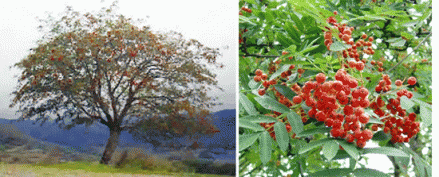
The rowan berry, the fruit of the rowan tree is one of the most well known and noticeable of the autumnal fruit, being ripe in mid October. It's also the wild fruit typically treated with the most suspicion and it's the fruit that almost everyone will avoid. There is some sense in this as rowan berries contain parasorbic acid which can cause indigestion and kidney damage. But, if frozen or cooked this is converted to sorbic acid (which makes rowan berries bitter) and this is probably the reason why rowan berries are typically only picked after the first frosts.
In fact rowan berries are very versatile fruit and can be made into jellies (the typical use) or they can be made into wine, cordials, syrups and form the basis for wonderful game sauces. You will find here a link to an extensive list of rowan berry recipes.
7, Hazelnuts and Cobnuts
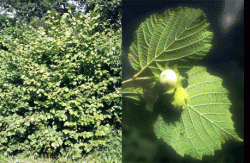
When it comes to mid to late October, the next fruit to be ready is the hazelnut, fruit of the Hazel tree. This can either be the wild hazelnut or the common cultivar, the cobnut (which now grows wild in many places). This is an excellent nut for cooking and was an autumn staple for our ancestors. Apart from in Kent, in the UK (the home of the cobnut it's not much used these days, which is a shame as it's an extremely versatile nut, as this list of cobnut and hazelnut recipes will show you.
